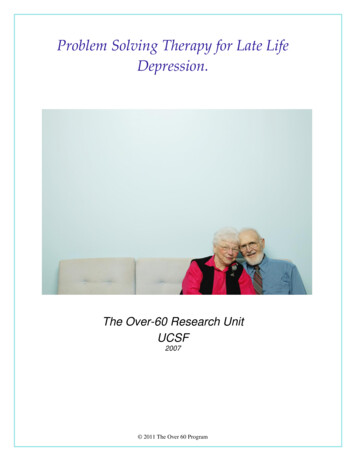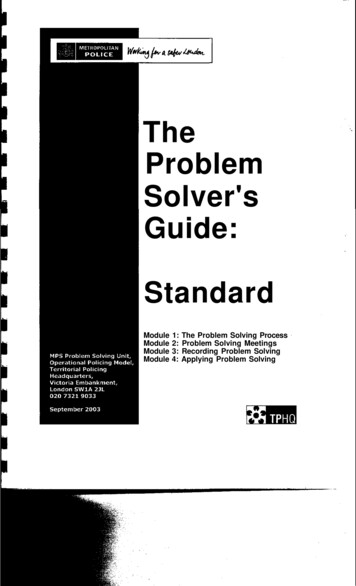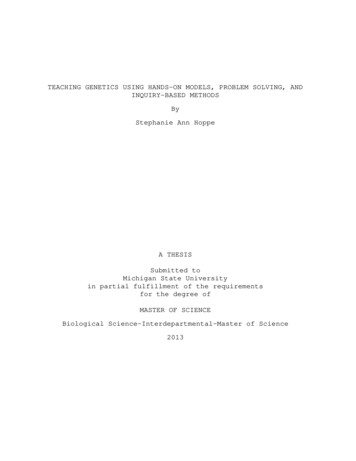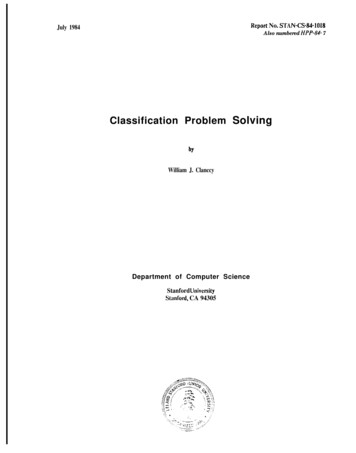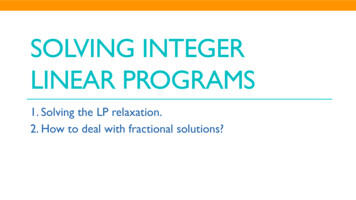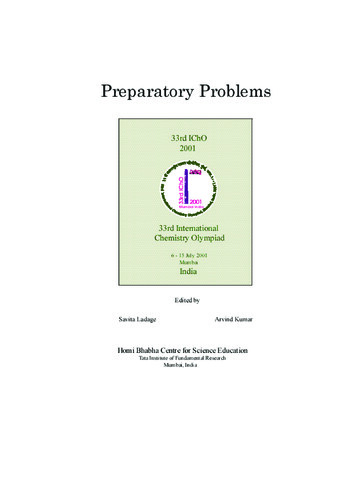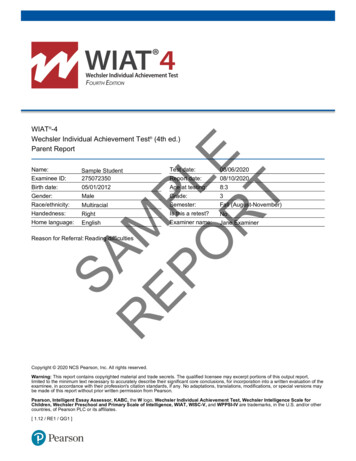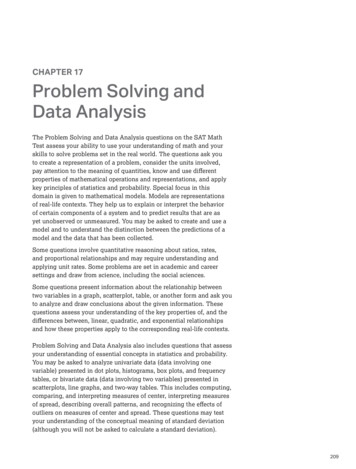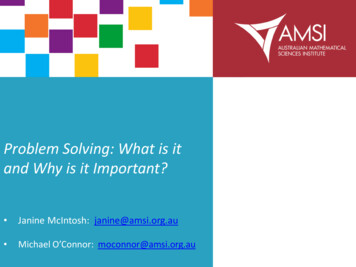
Transcription
Problem Solving: What is itand Why is it Important? Janine McIntosh: janine@amsi.org.au Michael O’Connor: moconnor@amsi.org.au
Problem SolvingWhat, exactly, is Problem Solving?Take a few moments to write down your currentworking definition of Problem Solving.
Problem SolvingWhy is it important?Now write down why it is important to include problemsolving as a core element of the mathematicscurriculum.If you disagree with it being given such a central role,write down your reasons for this instead.
Problem SolvingWhen and How oftenIn your classroom currently:When do you work on problems and problem solving?How often do you spend at any one time?
Problem SolvingHow good are you?On a scale from 1 to 10, give yourself a score for howconfident you feel in solving problems.
Problem SolvingThe “Official” DefinitionStudents develop the ability to make choices, interpret,formulate, model and investigate problem situations,and communicate solutions effectively. Studentsformulate and solve problems when they usemathematics to represent unfamiliar or meaningfulsituations, when they design investigations and plantheir approaches, when they apply their existingstrategies to seek solutions, and when they verify thattheir answers are reasonable.(ACARA, /content-structure )
Problem SolvingYear Level DescriptionsIn addition to this overall statement, ACARA also hasdescriptions for what Problem Solving looks like at eachyear level.These are available in collated form both on Calculateand in the AMSI Teacher Journal. They are alsoreproduced in the following slides.
Problem SolvingYears F to 2YearDescriptionFProblem Solving includes using materials to model authenticproblems, sorting objects, using familiar counting sequencesto solve unfamiliar problems, and discussing thereasonableness of the answerModel, solve,discussreasonableness1Problem Solving includes using materials to model authenticproblems, giving and receiving directions to unfamiliarplaces, and using familiar counting sequences to solveunfamiliar problems and discussing the reasonableness ofthe answerProblem Solving includes formulating problems fromauthentic situations, making models andusing number sentences that represent problem situations,and matching transformations with their original shapeModel,communicatedirections, solve,discussreasonablenessFormulate, model,comparisonmatching2Keyword
Problem SolvingYears 3-4YearDescriptionKeyword3Problem Solving includes formulating and modelling authentic Formulate, model,situations involving planning methods of data collection andrepresentation, making models of three-dimensional objectsand using number properties to continue number patterns4Problem Solving includes formulating, modelling andFormulate, model,recording authentic situations involving operations, comparing record, comparelarge numbers with each other, comparing time durations, andusing properties of numbers to continue patterns
Problem SolvingYears 5-6YearDescriptionKeyword5Problem Solving includes formulating and solving authenticproblems using whole numbers and measurements andcreating financial plansFormulate,6Problem Solving includes formulating and solving authenticproblems using fractions, decimals, percentages andmeasurements, interpreting secondary data displays,and finding the size of unknown anglesFormulate, solve,interpret,
Problem SolvingYears 7-8YearDescription7Problem Solving includes formulating and solving authenticproblems using numbers and measurements, working withtransformations and identifying symmetry, calculatingangles and interpreting sets of data collected throughchance experimentsProblem Solving includes formulating,and modelling practical situations involving ratios, profitand loss, areas and perimeters of common shapes, andusing two-way tables and Venn diagrams to calculateprobabilities8KeywordFormulate, te, model,convert/translateinformation
Problem SolvingYears 9-10Year91010ADescriptionProblem Solving includes formulating,and modelling practical situations involving surface areasand volumes of right prisms, applying ratio and scale factorsto similar figures, solving problems involving right-angletrigonometry, and collecting data from secondary sources toinvestigate an issueProblem Solving includes calculating the surface areaand volume of a diverse range of prisms to solve practicalproblems, finding unknown lengths and angles usingapplications of trigonometry, using algebraic and graphicaltechniques to find solutions to simultaneous equations andinequalities, and investigating independence of eventsNo additional commentsKeywordFormulate, model,apply, solve,investigate,Apply, investigate,
Problem Solving“Problem solving at its most general was definedas trying to achieve some outcome, when therewas no known method (for the individual tryingto achieve that outcome) to achieve it .complexity or difficulty alone did not make atask a problem”Schoenfeld, 2013
Problem SolvingPolya: How to Solve it.First published in 1945, it says there are 4 stages insolving any problem1) Understand the problem2) Devise a plan3) Carry out the plan4) Look back
Problem SolvingA Satchel of StrategiesOr a Toolbox of Techniques.These can be built up overthe years.Often, a list of strategies,along with the 4 stages, arewritten on the classroomMaths Wall.Some example strategies Guess and check Look for a pattern Draw a table Reduce to a simpler case Act it out Work backwards Draw a sketch Divide into subtasks Substitute simple values
Problem SolvingWolfram’s “Doing Maths”Reproduced with permission. Copies of the poster are available poster/
Problem SolvingPolya againConnecting theother Proficiencies1) Understand the problemUnderstanding2) Devise a planReasoning3) Carry out the planReasoning & Fluency4) Look backFeedback, reflectionand metacognition
Problem SolvingWhy is it Important?1) Mathematics is more than just calculation.2) Real life, modern society and civilisation is full ofproblems large and small.3) Promotes links between concepts and topics leadingto greater understanding and new learning
Problem SolvingWhat makes a good Problem?These areregarded asthe essentialminimum forselection ofall problemsWhy is Problem Solving Important to Student Learning, NCTM Research Brief, April 2010
Problem SolvingWhat makes a good Problem?These criteria addvalue at differenttimes to thecollection ofproblems beingused.Why is Problem Solving Important to Student Learning, NCTM Research Brief, April 2010
Problem SolvingDeveloping an Integrated ApproachInvolves developing a mindset and a process to helpstudentsa) build skill and capacityb) encourage perseverancec) reflect on thinkingd) recognise multiple solutions may be possible
Problem SolvingDeveloping an Integrated ApproachMore than just a learning a strategy a week.While having a set of strategies is important, so ischoosing which strategy to use in a given situation andjustifying this choice.
Problem SolvingSense MakingMGA Spiral of developingunderstandingMason, J., et al, (2005), Developing Thinking in Algebra, SAGE Publications
Problem SolvingThe Zone of Proximal Development (ZPD)Developed by Vygotsky in the 1930’s in Soviet Union.Not until 1970’s that ideas reached the West.Used to assist students in the acquisition of knowledgeand skillsUseful also for formalising problem solving processes
Problem SolvingThe Zone of Proximal Development (ZPD)
Problem SolvingThe Zone of Proximal Development (ZPD)
Problem SolvingThe Zone of Proximal Development (ZPD)
Problem SolvingThe Zone of Proximal Development (ZPD)
Problem SolvingThe Zone of Proximal Development (ZPD)
Problem SolvingThe Zone of Proximal Development (ZPD)
Problem SolvingThe Zone of Proximal Development (ZPD)
Problem SolvingThe Zone of Proximal Development (ZPD)
Problem SolvingThe Zone of Proximal Development (ZPD)
Problem Solving“Flow”How does it feel to be in "the flow"?Completely involved, focused, concentrating - withthis either due to innate curiosity or as the result oftrainingSense of ecstasy - of being outside everyday realityGreat inner clarity - knowing what needs to be doneand how well it is goingKnowing the activity is doable - that the skills areadequate, and neither anxious or boredSense of serenity - no worries about self, feeling ofgrowing beyond the boundaries of ego - afterwardsfeeling of transcending ego in ways not thoughtpossibleTimeliness - thoroughly focused on present, don'tnotice time passingIntrinsic motivation - whatever produces "flow"becomes its own /24-flow-and-mihaly-csikszentmihalyi.html
Problem SolvingZPD - ScaffoldingBreaking up tasks or problems into more manageablepieces.Provision of hints and guides to assist students tocontinue progressing through the task.
Problem SolvingZPD - FadingThe removal of scaffolding structures from questionsand tasks.Promoting student reliance on previously developedproblem solving approaches.The goal is for students to develop new approaches ontheir own.Original discovery and Synthesis
Problem SolvingZPDZPD is more than just the determination of effect sizefrom pre and post testing.It is an attempt to help students process how they aregoing with their problem solving attempts
Problem SolvingBeing StuckWhat are the typical responses?1) Give up completely2) Put it away for a while3) Keep workingHaving rubrics or checklists can be useful4) CollaborationThinking Mathematically, Mason, Burton & Stacey, 1985
Problem SolvingThe Zone of ConfusionA term developed by Clarke et al“as something which some teachers might find helpfulin discussions with students about the different stagesthey might move through as they work on genuinelychallenging tasks”Clarke. D, et al, Australian Mathematics Teacher 70(1) 2014
Problem SolvingAnalysing Success or FailureSchoenfeld (1985) says that we need to know about theindividual’s:1) knowledge2) use of problem solving strategies3) Monitoring and self-regulation (part ofmetacognition)4) Belief systems (of self, of maths, of problem solvingand the origins of these in prior mathematicalexperiences
Problem SolvingMetacognitionTwo aspects:1) Knowledge of cognitionStrengths and weaknesses as a learner andproblem solverWhere, how and why to apply different strategies2) Monitoring and Regulation of cognitionWhere am I going?How am I going?Where to next?
Problem SolvingMetacognitionHeuristic skills“search strategies” for deciding which tools to apply tothe problem.This links directly to Polya’s list of strategies and the“toolkit” approach
Problem SolvingMultiple ApproachesConcreteRepresentationalAbstract
Problem SolvingMultiple ApproachesBuilt in Differentiation:
Problem SolvingPlaying with ProblemsThe rest of this session is devoted to exploring aselection of problems and critiquing them against thecriteria outlined above.HOMEWORKThis is the first of a 2 session presentation on ProblemSolving. Over the next few weeks, you are encouragedto find or develop your own problem solving tasks toshare with the group in session 2.
Problem Solving includes formulating and solving authentic problems using numbers and measurements, working with transformations and identifying symmetry, calculating
